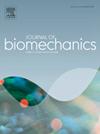Evaluation of a novel compliance-matching aortic graft in a swine model
IF 2.4
3区 医学
Q3 BIOPHYSICS
引用次数: 0
Abstract
The mismatch of elastic properties between the arterial tissue and the vascular grafts, commonly called compliance mismatch, is responsible for many deleterious post-operative complications. Currently, there is an absence of prostheses that conform with the compliance of healthy aortas. We aimed to evaluate the in vivo performance of novel compliance-matching grafts in a swine model and compare it to the native aorta and to gold-standard aortic grafts.We proposed a compliance-matching graft design, composed of a standard aortic graft surrounded by an optimized Nickel-Titanium compliance-augmenting layer. We replaced the thoracic aorta of six domestic pigs with compliance-matching grafts under cardiopulmonary bypass. We removed the compliance-regulating layer of the compliant grafts, so that gold-standard grafts remained implanted. The aortic pressure and flow rate were measured at the three stages of the experiment to assess hypertension and arterial stiffness. The compliance-matching grafts were implanted without inducing post-operative hypertension by maintaining systolic pressure (p = 0.26), aortic pulse wave velocity (p = 0.89) and aortic distensibility (p = 0.67) at healthy levels. The gold-standard grafts caused a significant rise in systolic pressure (p = 0.005), pulse wave velocity (p = 0.012) and they approximately doubled pulse pressure (p < 0.001). Our novel compliant grafts could diminish the complications caused by compliance-mismatch and they could surpass the clinical performance of existing prostheses. The proposed grafts comprise a step towards optimized treatment and improved life expectancy of patients subjected to aortic replacement.
在猪模型中评估新型顺应性匹配主动脉移植物
本文章由计算机程序翻译,如有差异,请以英文原文为准。
求助全文
约1分钟内获得全文
求助全文
来源期刊

Journal of biomechanics
生物-工程:生物医学
CiteScore
5.10
自引率
4.20%
发文量
345
审稿时长
1 months
期刊介绍:
The Journal of Biomechanics publishes reports of original and substantial findings using the principles of mechanics to explore biological problems. Analytical, as well as experimental papers may be submitted, and the journal accepts original articles, surveys and perspective articles (usually by Editorial invitation only), book reviews and letters to the Editor. The criteria for acceptance of manuscripts include excellence, novelty, significance, clarity, conciseness and interest to the readership.
Papers published in the journal may cover a wide range of topics in biomechanics, including, but not limited to:
-Fundamental Topics - Biomechanics of the musculoskeletal, cardiovascular, and respiratory systems, mechanics of hard and soft tissues, biofluid mechanics, mechanics of prostheses and implant-tissue interfaces, mechanics of cells.
-Cardiovascular and Respiratory Biomechanics - Mechanics of blood-flow, air-flow, mechanics of the soft tissues, flow-tissue or flow-prosthesis interactions.
-Cell Biomechanics - Biomechanic analyses of cells, membranes and sub-cellular structures; the relationship of the mechanical environment to cell and tissue response.
-Dental Biomechanics - Design and analysis of dental tissues and prostheses, mechanics of chewing.
-Functional Tissue Engineering - The role of biomechanical factors in engineered tissue replacements and regenerative medicine.
-Injury Biomechanics - Mechanics of impact and trauma, dynamics of man-machine interaction.
-Molecular Biomechanics - Mechanical analyses of biomolecules.
-Orthopedic Biomechanics - Mechanics of fracture and fracture fixation, mechanics of implants and implant fixation, mechanics of bones and joints, wear of natural and artificial joints.
-Rehabilitation Biomechanics - Analyses of gait, mechanics of prosthetics and orthotics.
-Sports Biomechanics - Mechanical analyses of sports performance.
 求助内容:
求助内容: 应助结果提醒方式:
应助结果提醒方式:


